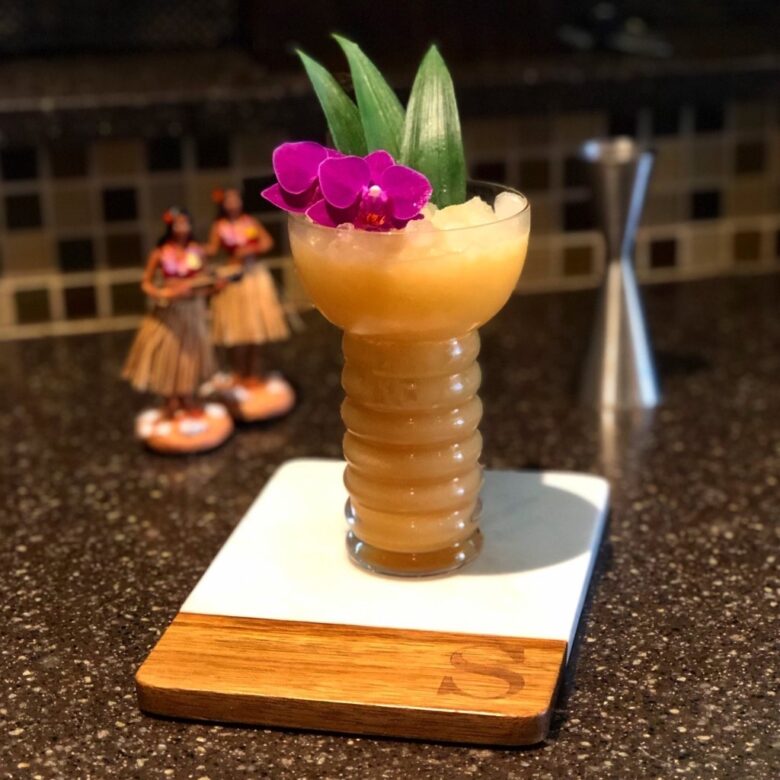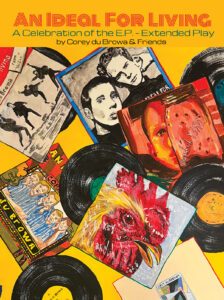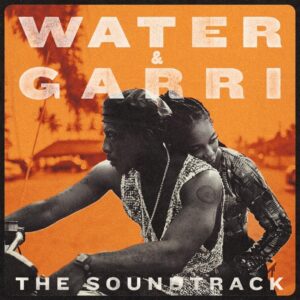Pearl Diver – recipe below.
During the early 1970s I lived in Salt Lake City for several years in my late grade school/junior high years. As a gentile living in the land of LDS, we would occasionally visit an iconic restaurant in SLC called Johnny Quong’s The Hawaiian. The crazy Polynesian themed Tiki restaurant had lightning storms every 20 minutes where lights would flash, thunder would roar, and an elaborate sprinkler system would create a downpour while we pleasantly ate under grass thatch roof structures. My parents always had a goofy (to me) Tiki cocktail with umbrellas and straws, in an angry-faced ceramic glass. Being too young to drink, I always associated the big drinks with the truly awful cocktails and mixed drinks of the 70’s – Harvey Walbangers and Tequila Sunrises – drinks with a lot of juice and a lot of flavorless vodka. How wrong I was. It took until I started really getting into cocktails that I began to explore Tiki drinks in earnest and saw the complexity of the drink. And I saw the cheap-ass liquor of my youth – rum – in a whole new light. The more I research, the more I realize what I still have to learn. I am still grappling with the complexities of the three main styles of rum. Not light, dark, and spiced – English, Spanish, and French.
In my post last week, I talked about the history of Caribbean rum, and its relationship with America. But that is primarily British Rum. Sugar made a lot of people very, very wealthy – rivaling the wealth of the Kings of Europe. So many other countries got in the act. It was relatively easy for a small band of mercenaries to invade and conquer a tiny Caribbean island and claim it for their mother country during the colonial period. England, France, and Spain were the main colonizers – with Portugal primarily in Brazil (making cachaça). Each at the time made rum a little differently to ship back home, and although most now make rum in multiple ways, the three primary methods all create liquors with slightly different tastes and are still used to classify types of rum.
Pot Still
British Rum
Made from the waste molasses from the cooking of the sugar cane, British rum is traditionally made in a pot still and is blended before aging. It has a rich and aromatic taste profile and it tends to retain its base molasses flavor. The pot stills are limited in size, resulting in smaller batches, but a more powerful rum. They tend to have longer fermentation times which result in a more intense flavor. Rums from Barbados, Jamaica, Bermuda, Guyana, St. Lucia, Bahamas are British Rums are all British Rums.
Spanish Rom
Like British, Spanish rum is also distilled from molasses, but is smoother than British rums. Spanish rums primarily use column, or multi-column stills and end up as more neutral base spirits after distillation. These rums are lighter and are fermented for shorter periods of time. Rums from Cuba, Puerto Rico, Panama, Trinidad, Dominican Republic, and Nicaragua are considered Spanish Rom. Most likely this is the rum you have in your liquor cabinet.
Column Still
French Agricole Rhum
French rum, on the other hand, is distilled directly from the fresh pressings of the sugar cane. The agricultural rum (Agricole) is grassy, floral, and earthy, and retains more of the original sugar flavor. Traditionally the Agricole rums were bottled unaged – although this is beginning to change, and aged French rums are common. Cognac and Armagnac barrels are often used to age the distilled spirit. Rums from Martinique, Guadeloupe, and Haiti are considered French Rhums.
Now back to the Tiki Cocktails. You may think of Tikis as simply a bunch of alcohol, mixed with a bunch of juice, and topped with a paper umbrella. But most authentic Tiki cocktails include at least three different rums – all using the slight variations of the different rums together to form a unified, but highly complex and delicious, cocktail. The exact opposite of a Tequila Sunrise. And this complexity would not be possible without the differing styles of rum – along with the different types of subsets you see at the store; light, gold, dark, spiced, navy, and black strap.
The Pearl Diver (from above)
3/4oz fresh lime juice
1oz fresh orange juice
3/4oz Gardenia Mix (below)
3/4oz Demerara rum
1-1/2oz gold Puerto Rican rum
1/2oz gold Jamaican rum
1tsp falernum
3 pineapple fronds garnish
Orchids for garnish.
.
Add everything to a shaker with ice (ice last – because of the butter), and shake for 15 seconds. Strain into a Pearl Diver or Tiki glass and add crushed ice to fill. Add garnish and serve.
.
Gardenia Mix:
1/2 cup unsalted butter, cubed
1/2 cup orange blossom honey
1/2oz cinnamon syrup
1/4oz St. Elizabeth allspice dram
1/4oz vanilla simple syrup
Combine all ingredients in a saucepan over medium heat and whisk until melted and smooth. Let cool and keep at room temperature.
Not quite like the three ingredient (and overly orange-y) Harvey Wallbanger. The Pearl Diver is another in a long list of iconic Tiki drinks created by Don Beach, and holy crap – it is delicious.
Next: Shaken, not stirred
AotCB-06
Instagram@architecture_of_the_cocktail
- Bill Stott
Other RUMinations in Architecture of the Cocktail:
HAVE YOU EVER HAD A REAL DAIQUIRI? by Bill Stott
The Golden Age of Cocktails, by Bill Stott
Hogo! by Bill Stott
How about a nice Hawaiian punch? by Bill Stott
“What one rum can’t do, three rums can” by Bill Stott
Yo, ho, ho, and a Bottle of Rum, by Bill Stott
Yo, ho, ho, and a Bottle of Rum – Part II, by Bill Stott
Spirits Up! Black Tot Day, by Bill Stott



